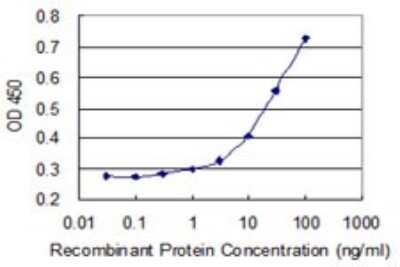PHKA2 Products
PHKA2, also known as Phosphorylase b kinase regulatory subunit alpha, liver isoform, is a 1,235 amino acid protein that is 138 kDa, predominantly expressed in liver and other non-muscle tissues, acts as a catalyzer of the phosphorylation of serine in certain substrates, including troponin I, and its alpha chain may bind calmodulin. This protein has been linked to several diseases and disorders including glycogen storage disease, x-linked liver glycogenosis type 1, hepatitis, glycogen storage disease, type ixa2, glycogen storage disease, type ixa1, coffin-lowry syndrome, muscle glycogenosis, Japanese encephalitis, retinoschisis, metabolic disorders, encephalitis, chagas disease, fanconi syndrome, hepatitis c hypertriglyceridemia, myopathy, hypercholesterolemia, hepatocellular carcinoma, psoriasis, and pneumonia. The PHKA2 protein has also shown an interaction with SMAD9, UBE3A, RAF1, LMLN, and METTL13 in the metabolism of carbohydrates, glycogen breakdown (glycogenolysis), metabolism, glucose metabolism, calcium signaling pathway, insulin signaling pathway, and signal transduction cAMP signaling pathway.
Show More
7 results for "PHKA2" in Products
7 results for "PHKA2" in Products
PHKA2 Products
PHKA2, also known as Phosphorylase b kinase regulatory subunit alpha, liver isoform, is a 1,235 amino acid protein that is 138 kDa, predominantly expressed in liver and other non-muscle tissues, acts as a catalyzer of the phosphorylation of serine in certain substrates, including troponin I, and its alpha chain may bind calmodulin. This protein has been linked to several diseases and disorders including glycogen storage disease, x-linked liver glycogenosis type 1, hepatitis, glycogen storage disease, type ixa2, glycogen storage disease, type ixa1, coffin-lowry syndrome, muscle glycogenosis, Japanese encephalitis, retinoschisis, metabolic disorders, encephalitis, chagas disease, fanconi syndrome, hepatitis c hypertriglyceridemia, myopathy, hypercholesterolemia, hepatocellular carcinoma, psoriasis, and pneumonia. The PHKA2 protein has also shown an interaction with SMAD9, UBE3A, RAF1, LMLN, and METTL13 in the metabolism of carbohydrates, glycogen breakdown (glycogenolysis), metabolism, glucose metabolism, calcium signaling pathway, insulin signaling pathway, and signal transduction cAMP signaling pathway.
Show More
| Applications: | WB, ELISA, MA, AP |
| Applications: | WB, ELISA, MA, AP |
| Reactivity: | Human |
| Details: | Rabbit IgG Polyclonal |
| Applications: | IHC, ICC/IF |
| Reactivity: | Human |
| Details: | Mouse IgG2a Kappa Monoclonal Clone #3H3 |
| Applications: | IHC, ELISA |
| Reactivity: | Human |
| Details: | Mouse IgG Polyclonal |
| Applications: | WB |
| Reactivity: | Human |
| Details: | Rabbit IgG Polyclonal |
| Applications: | WB |
| Reactivity: | Human |
| Details: | Mouse IgG2b Kappa Monoclonal Clone #1D4 |
| Applications: | ELISA |



![Immunocytochemistry/ Immunofluorescence: PHKA2 Antibody [NBP1-92264] Immunocytochemistry/ Immunofluorescence: PHKA2 Antibody [NBP1-92264]](https://resources.bio-techne.com/images/products/PHKA2-Antibody-Immunocytochemistry-Immunofluorescence-NBP1-92264-img0005.jpg)
![Immunohistochemistry-Paraffin: PHKA2 Antibody (3H3) [H00005256-M04] Immunohistochemistry-Paraffin: PHKA2 Antibody (3H3) [H00005256-M04]](https://resources.bio-techne.com/images/products/PHKA2-Antibody-3H3-Immunohistochemistry-Paraffin-H00005256-M04-img0001.jpg)
![Western Blot: PHKA2 Antibody [H00005256-B01P] Western Blot: PHKA2 Antibody [H00005256-B01P]](https://resources.bio-techne.com/images/products/PHKA2-Antibody-Western-Blot-H00005256-B01P-img0002.jpg)
![Western Blot: PHKA2 Antibody [H00005256-D01P] Western Blot: PHKA2 Antibody [H00005256-D01P]](https://resources.bio-techne.com/images/products/PHKA2-Antibody-Western-Blot-H00005256-D01P-img0001.jpg)
